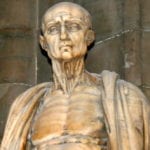 Mysteries
Mysteries  Mysteries
Mysteries  History
History 10 Surprising Stories About the Texas Rangers
 Humans
Humans 10 Philosophers Who Were Driven Mad by Their Own Theories
 Miscellaneous
Miscellaneous 10 Video-Game-Worthy Weapons and Armors from History
 Weird Stuff
Weird Stuff 10 Psychics Who Accurately Predicted Wartime Events
 The Arts
The Arts 10 Pieces of Art Inspired by a Broken Heart
 Health
Health 10 Science Fiction-Sounding New Medical Treatments
 History
History 10 Surprising Facts About the Father of Submarine Warfare
 Space
Space Ten Astonishing New Insights into Alien Worlds
 Weird Stuff
Weird Stuff 10 Bizarre Summer Solstice Rituals Still Practiced Today
 Mysteries
Mysteries Top 10 Haunting Facts About the Ghost Ship MV Alta
 History
History 10 Surprising Stories About the Texas Rangers
 Humans
Humans 10 Philosophers Who Were Driven Mad by Their Own Theories
Who's Behind Listverse?

Jamie Frater
Head Editor
Jamie founded Listverse due to an insatiable desire to share fascinating, obscure, and bizarre facts. He has been a guest speaker on numerous national radio and television stations and is a five time published author.
More About Us Miscellaneous
Miscellaneous 10 Video-Game-Worthy Weapons and Armors from History
 Weird Stuff
Weird Stuff 10 Psychics Who Accurately Predicted Wartime Events
 The Arts
The Arts 10 Pieces of Art Inspired by a Broken Heart
 Health
Health 10 Science Fiction-Sounding New Medical Treatments
 History
History 10 Surprising Facts About the Father of Submarine Warfare
 Space
Space Ten Astonishing New Insights into Alien Worlds
 Weird Stuff
Weird Stuff 10 Bizarre Summer Solstice Rituals Still Practiced Today
Top 10 Truly Badass Saints
We all think of Saints as quiet and holy people – but history is full of some pretty amazing and curious people who came to be canonized. This list looks at ten of the toughest saints to have walked the earth – men and women who not only lived holy lives, but kicked some serious butt at the same time. For those of you who don’t know the specifics of what sainthood is, here is a brief summary before we start on the list. A saint is a person who lived a life of virtue. Many saints from the early Church are saints by general acclamation – in other words, they were so popular that they simply came to be known as saints. But, from very early on in Christianity, a saint was declared as such by the Pope (or in the case of martyrs, by the local Bishop). Literally, the term “saint” refers to any person who is in Heaven – not just those so named by the Church. But enough of the details – here are ten saints you don’t want to meet in a dark alley.
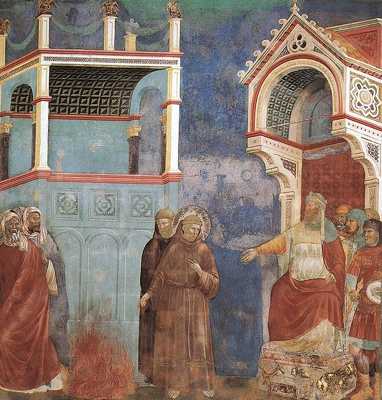
I bet you weren’t expecting to see St Francis on this list. St Francis is best remembered in popular culture as the animal patron – the saint who could talk to animals and sooth wild beasts. While it is true that there were many reports of miracles regarding animals in St Francis’ life, he is more revered in the Church because of his strict poverty, stigmata and efforts to fix problems in the Church during a time of crisis. But what most people don’t know (including many religious people) is that St Francis was so devout in his beliefs that he raced off to Egypt in 1219 to become a martyr – he hoped that he would convert a bunch of muslims and then be killed. That was a hope that nearly came true!
St Francis was received by Sultan Melek-el-Kamel, whom he wanted to convert, and suggested that his muslim scholars undergo a test of true religion by fire. They all refused, so St Francis offered to enter a fire pit and, if he was able to leave it unharmed, they would have to agree that God had protected him and that his was, therefore, the true religion. The sultan rejected his offer but was so impressed that he gave St Francis permission to preach Christianity unhindered in his lands – an incredible concession considering the nation was in the middle of fighting against crusaders from the west. This saint was definitely a man of steel.
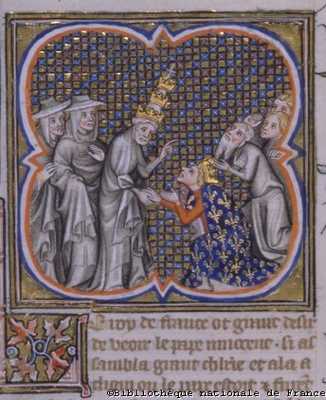
Saint Louis was the King of France from 1226 until his death in 1270, and is the only canonized King of France. He was crowned King at only 12 years old, following the death of his father, King Louis VIII. Because of his youth, his mother, Blanche of Castile, ruled France as regent during his minority. He went on two crusades during his lifetime, one in his mid thirties, and the other in his mid 50’s, which is no mean feat when you consider how bloody and violent they could be. The first began with the capture of Port Damietta in 1249, and went on to the Battle of Fariskur, where he lost his army and was captured by the Egyptians. He was only released after a ransom of 400,000 livres tournois was paid (nearly twice France’s annual revenue), and the return of the city of Damietta.
Perhaps most significant for the badassness of King Louis was that the whole time he was battling, he was wearing a cilice (a sharp metal chain worn tightly to cause pain and sometimes bleeding) around the legs or waist. So when everyone else was suffering because of battle scars, the King was suffering twice. His end was to come in his second crusade when he died – as all good kings do – in the midst of a bloody battle.
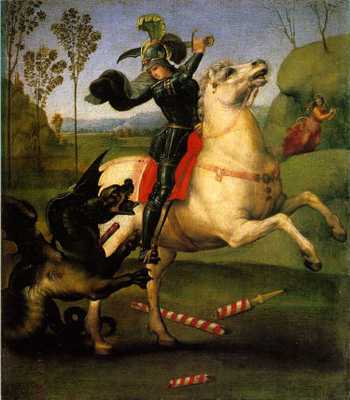
St George is undoubtedly amongst the most well known saints on this list. He was a third century Roman soldier and a priest in the Guard of Diocletian, who is venerated as a Christian martyr. He is regarded as the most prominent military saint and is one of the most revered in the Western World. George was raised as a Christian and decided at a young age that he wanted to be a soldier. He joined Diocletian’s army and, before long, was one of the finest soldiers around. Some time later Diocletian decided that all soldiers who were Christians had to renounce their faith and become pagan. George refused (I am sure you all see where this is going). Diocletian tried to convince him to convert because he didn’t want to lose his best soldier but George refused.
Recognizing the futility of his efforts, Diocletian was left with no choice but to have him executed for his refusal. Before the execution George gave his wealth to the poor and prepared himself. After various torture sessions, including laceration on a wheel of swords, in which he was resuscitated three times (pretty damned badass), George was executed by decapitation before Nicomedia’s city wall, on April 23, 303.
But most of all he is a badass because he killed a dragon or so the legend goes. Here is the story of St George and the Dragon:
“In the fully developed Western version, which developed as part of the Golden Legend, a dragon or Crocodile makes its nest at the spring that provides water for the city of “Silene” (perhaps modern Cyrene) in Libya or the city of Lydda, depending on the source. Consequently, the citizens have to dislodge the dragon from its nest for a time, to collect water. To do so, each day they offer the dragon at first a sheep, and if no sheep can be found, then a maiden must go instead of the sheep. The victim is chosen by drawing lots. One day, this happens to be the princess. The monarch begs for her life to be spared, but to no avail. She is offered to the dragon, but there appears Saint George on his travels. He faces the dragon, protects himself with the sign of the cross, slays the dragon, and rescues the princess. The grateful citizens abandon their ancestral paganism and convert to Christianity.” [Source]
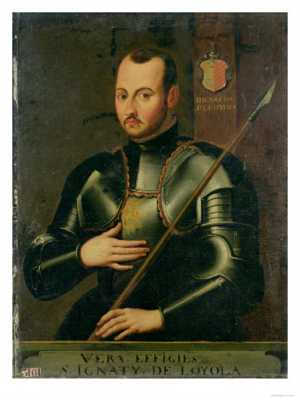
Ignatius of Loyola (Basque: Ignazio Loiolakoa, Spanish: Ignacio de Loyola) (1491 – July 31, 1556) was a Spanish knight from a Basque noble family, hermit, priest since 1537 and theologian, who founded the Society of Jesus (the Jesuits) and was its first Superior General. St Ignatius was an incredibly brilliant Knight who fought in many battles without any injuries, until one fateful day. On May 20, 1521, a cannonball wounded one of his legs and broke the other. Unperturbed, he got up and hobbled back to the castle. He needed surgery which was undertaken without anesthesia – a treatment that most modern folk would balk at. Part of his leg bone had to be cut off, and the operation was generally a disaster. But, despite the fact that he ended up with one leg shorter than the other (which led the doctors to put weights on his leg to stretch it back out), he survived and went on to found one of the most famous religious orders in the world (inspired by the religious texts he read while recovering from the cannonball).
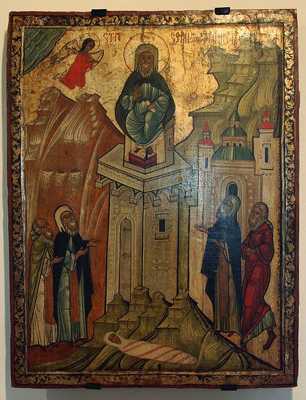
Saint Simeon Stylites lived for 37 years standing on top of a small platform on a tall pillar. That is sufficient to label him badass. Before this he spent 40 days closed in a tiny hut without any food or water. When he walked out it was hailed as a miracle. Pilgrims flocked to see St Simeon and they erected taller pillars for him to stand on – in the end his pillar was 15 meters high. He lived off goat’s milk and flat bread – provided by local children. He refused to let any women come near the pillar (including his mother) and he would let people climb a ladder to talk to him and ask for advice.
St Simeon truly cemented his name in the annals of badass history when he got an ulcer on his thigh which festered and ultimately led to his death – standing up.
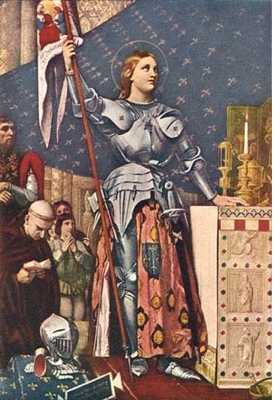
“Forward! They are ours!” That was the battle cry of Saint Joan of Arc, the young virgin who led the French army to several important victories during the Hundred Years’ War, which paved the way for the coronation of Charles VII.
In one battle, Saint Joan was hit in the neck by an arrow. Unlike most men in war, she didn’t take it lying down; she got right back up, pulled out the arrow and continued to lead the army. In another battle, whilst scaling a wall to attack the English, she was hit in the head with a canon ball – as is to be expected of a warrior saint, she shook her head and kept climbing. Her leadership (and battle style, which was 100% attack) shattered the English Army wherever it met her.
She was captured by the Burgundians, sold to the English, tried by an ecclesiastical court and burned at the stake when she was nineteen years old. 25 years later the Pope (Pope Callixtus III) investigated the trial at the request of Saint Joan’s mother, Isabelle Romée, and the Inquisitor General overturned it and declared that Joan was a martyr. It took 500 years before she was officially canonized. Oh – and contrary to popular belief, St Joan didn’t dress in men’s clothing – she fought all of her battles in a dress with armor over the top.
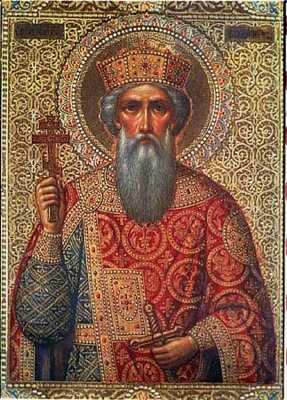
Which saint had hundreds of concubines, multiple wives from around the world, so many children that everyone lost count, and an army of pagans? St Vladimir of Kiev did! Vladimir was the grand prince of Kiev, who converted to Christianity in 988, but before his conversion he was a pretty mean (not to mention profligate) guy. From the start of his reign in 980, he conquered lands, slaughtered people, had children and generally partied hard. On a few occasions he, being a good Pagan, took part in human sacrifices:
“In 983, after another of his military successes, Prince Vladimir and his army thought it necessary to sacrifice human lives to the gods. A lot was cast and it fell on a youth, Ioann by name, the son of a Christian, Fyodor. His father stood firmly against his son being sacrificed to the idols. More than that, he tried to show the pagans the futility of their faith: ‘Your gods are just plain wood: it is here now but it may rot into oblivion tomorrow; your gods neither eat, nor drink, nor talk and are made by human hand from wood; whereas there is only one God — He is worshiped by Greeks and He created heaven and earth; and your gods? They have created nothing, for they have been created themselves; never will I give my son to the devils!’”
Interestingly, it was this speech which caused Vladimir to ponder over the next few years as to whether he ought to convert to Christianity, which he ultimately did. He ruled so kindly after his conversion that he became known as Vladimir the Great – a far cry from his previous life.
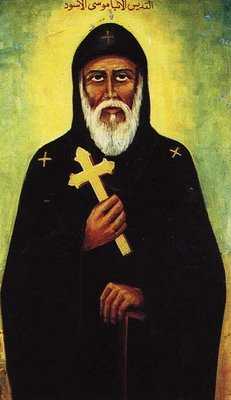
St Moses the Black was a slave of a government official in Egypt who dismissed him for theft and suspected murder. He became the leader of a gang of bandits who roamed the Nile Valley, spreading terror and violence. He was a large, imposing figure. On one occasion a man caught him in a theft, which annoyed St Moses immensely. The next day he swam across the Nile (a not insignificant act) with a knife in his mouth – his intention was the kill the guy. When he got to his home the guy had fled (having obviously heard some of Moses’ previous exploits). St Moses, instead, killed four of his sheep before sticking the knife back in his mouth and swimming back. Shortly after that the law started to catch up with him so he hid in a monastery. The influence of the monks was so great that he converted and became a monk.
But the story doesn’t end there. Some years later a group of thieves wanted to rob the monastery where St Moses was living. He caught them off guard and single handedly beat them all to a pulp. He dragged their bloodied bodies to the chief monk to ask what to do (knowing it wasn’t a monkly thing to kill them). The head of the monastery said to forgive them and send them away, which surprised the robbers so much that they all apologized, converted and became monks too! He eventually died at the hands of a group of warriors who attacked the monastery when he was 75 years old – but not before he managed to help 70 of the monks escape. St Moses chose to stay behind with a few other monks to fight off the warriors.
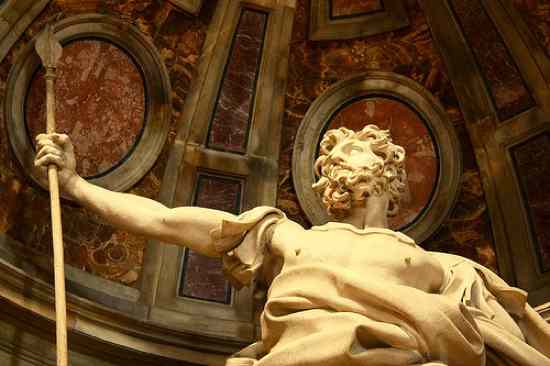
St Longinus was a soldier in the Roman army, from Caesarea. He spent his life earning his pension by fighting with his fellow soldiers throughout the Roman lands, and eventually ended up in Jerusalem helping out with various tasks he was capable of (he was nearly blind). One of the tasks was to be life changing. St Longinus was instructed to assist at the crucifixion of Jesus. Being a good Roman soldier he took his work seriously and, ensuring that he get a promotion for doing a good job, stabbed Jesus in the side while he was on the cross. In other words, Longinus stabbed God. It takes a true badass to have the guts to do something like that.
Blood and water flowed out from the stab wound and some of it got in Longinus’ eyes. His blindness vanished and he declared “Indeed, this was the Son of God!” [Mark 15:39]. He immediately left the army, converted and became a monk. Not long after he was arrested for his faith, his teeth ripped out and tongue cut off. However, St. Longinus continued to speak clearly and managed to destroy several idols in the presence of the governor, who consequently had Longinus beheaded. His relics are now in the church of St Augustine, in Rome, and the lance he used to stab Jesus is contained in one of the four pillars over the altar in the Basilica of St Peter’s in Rome.
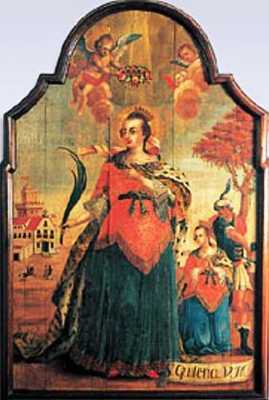
This entry is number one on the list for not just the badassness of St Quiteria, but the downright weird circumstances of her life. St Quiteria was one of nine sisters all born at the same time (nonuplets). The nine girls’ mother was a lady of high rank and she was disgusted that she had given birth to nine children like a common animal and even more so that she had nine daughters and no son (son’s were far more valuable). In a fit of rage, she demanded that her nurse take the babies and drown them in the river. The nurse couldn’t do it so she took them to a remote village where the girls grew up together. Then things get really weird. They formed a nonuplet warrior gang.
The girls were all good Christians and their gang was formed to travel around breaking Christians out of jail. They spent a number of years in this task (and smashing Roman idols) until they were caught and returned to their father, who recognized them. He told them all to marry good Roman pagans but they refused and broke out of jail. Then the real badass began. They waged a guerilla war against the Roman Empire. Eventually, the girls were all killed or died (Quiteria was beheaded) and along with Quiteria, two of her sisters Marina and Liberata are saints.


